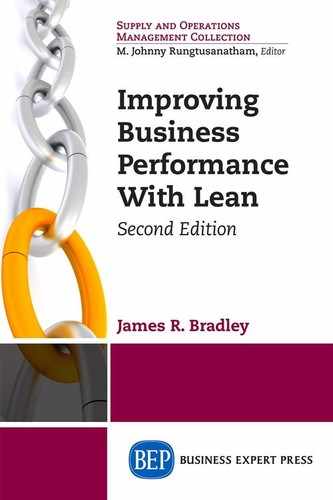About This Book
This book is structured to succinctly describe how to apply the tools associated with Lean to improve business processes. It can be thought of as a quick-start manual that covers the essential tools, philosophies, and implementation strategies of Lean. The tools covered herein are those, in the author’s experience, most frequently applied and generally applicable to processes in all contexts. Descriptions of other, less frequently used tools can be found in the citations included in this book. There are many soft issues with implementing Lean, such as how to organize a companywide effort, how to provide proper incentives, and how to build a culture conducive to Lean. Although this book addresses these important issues, more comprehensive coverage is available in other resources. This book does contain all the philosophical underpinnings related to Lean in general and, in particular, to the tools that are described. In summary, this book has attempted to include the most vital information for a reader whose goal is to effectively practice Lean as soon as possible. Including any additional materials that would not likely be immediately needed and would have unnecessarily delayed the reader from getting started with Lean. Therefore, this book can be thought of as a lean presentation of Lean.
The main text in each chapter is presented as simply and clearly as possible to communicate the essence of Lean and its tools. The finer details of Lean that are necessary, but that might sidetrack a reader, are presented in sidebars throughout the book. A reader who ignores these frames upon the first reading will still be presented with a comprehensive description of the main concepts. The reader might, however, want to return to these finer points in subsequent passes through the material after he or she understands the basics and begins to apply Lean.
Readers will find that the techniques encompassed by Lean are very intuitive and quickly learned. However, as with any topic, the lessons of Lean cannot be fully absorbed until they are practiced. Therefore, practical exercises are included at the end of chapters that suggest how a reader can further his or her understanding by applying Lean in real settings. In addition, questions are provided in association with these exercises where appropriate to help readers reflect on their experience with the exercises to maximize the learning benefit. Spending some time quietly and thoughtfully entertaining these questions will greatly enhance the benefit of the exercises. Other exercises are also presented at the end of the chapters where concepts can be explored in the format of a typical homework problem.
This book can be used in many modes. It can be used as a self-study reference, or it can be used in a course. In either case, case studies are provided in the appendix to this book that offer the opportunity to exercise all the concepts in the book and might serve as a final examination in a course. Ideally, this book can be used as a text in a course where students are applying Lean in real companies while simultaneously studying this book and using it as a reference.
This book is divided into three parts. Part I, Basics of Lean, describes the motivation for why companies and organizations should want to do Lean, basic process analysis and mapping skills, and the discipline that a company must demonstrate in order to make Lean successful. Part II, Lean Tools, discusses tools used in Lean to improve processes. This part of the book does not contain an exhaustive reference to all the tools used in Lean but rather the most frequently used tools in manufacturing, service, and administrative processes. Part III, Implementing Lean, discusses how to implement Lean, as well as some of the more frequently encountered roadblocks. Mastering Lean requires practice and Part IV offers opportunities for practice.
